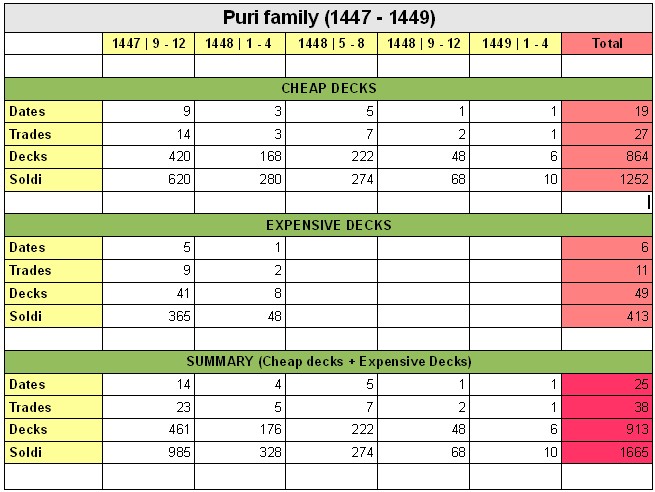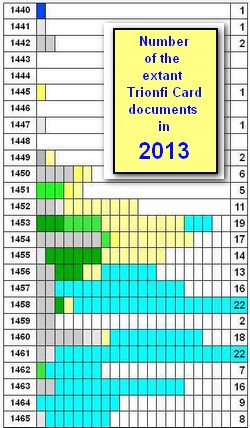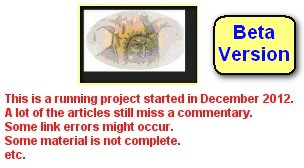Puri family, trader in Florence
composed by Lothar Teikemeier, last updated 06.12.2012,
|
Observation:
The Puri family sold 49 decks for 5 Soldi or higher. Between these the Puri family sold 4 decks "above 20 Soldi" and 4 others near to 20 Soldi, all 8 decks were produced by Paparello and directly or indirectly connected to the attribute "Chorone", which for the moment presents an unsolved riddle. There's some suspicion, that Chorone might have been used as a name for a Trionfi card variant, something, which for instance in the broader definitions of Jacopo Antonio Marcello might have been called "a new Ludus Triumphorum". Another artist, who supplied the Puri family with playing cards, had been Giovanni di ser Giovanni, nicknamed "Lo Scheggia", brother of the very famous artist Masaccio, who died early. Though less famous than his brother, Lo Scheggia is the only new Trionfi artist of a greater name in Florence and at the international market works of him are occasionally traded for 500.000 $ and more. Further there is the very interesting information, that in one of his pictures a naked Lady looks very similar to a Trionfi card used in an extant deck fragment once in the hands of Alessandro Sforza, Lord of Pistoia. Between his works appear scenes from triumphal processions. Famous is a birth tray for Lorenzo di Medici, commissioned 1449 and showing a typical Fame in Petrarca's Trionfi poem style. A third artist's name mentioned in the Puri family sale lists is not clearly readable, but the suspicion exists, that this might be Antonio di Dino Canacci, well known for his activities with the silk dealers, but also with the Lapini family. ListsFranco Pratesi had splitted in his article the sales in a cheap category (sold in dozens) and an expensive category (here 5 Soldi and higher). I transformed his data to an overview, counting dates of sales, sale activities, number of decks and received money. Cheap decks are nearly always sold in dozens, so it's clear, that this list only contained trades with clients, who sold decks themselves (for instance traders like Ser Andrea di Giovanni Bertelli, who in a half year sold about 20 decks, and nearly all as a single deck(and none of the decks above 5 Soldi and 6 denari. If the Puri family really also sold decks to final users of card playing, these humble everyday-trades don't appear on their lists (as far we know them).
|
|
Sources
Sources are mainly taken from Franco Pratesi's new article series written from November 2011 till now, published here at Trionfi.com.| SOURCE 1: Puri family |
|
Quote from Franco Pratesi: "1447-1449 - NAIBI ON SALE", 21.01.2012 |
Puri and other merciaiIt is not easy for me to define exactly what a "merciaio" is, and what a merciaio was. The word directly comes from "merce", and merce has an English equivalent in goods, wares, so that the shop may be intended at once as a shop where any goods can be sold and acquired; merchant (or "mercante" here) has exactly the same etymology, but is used for bigger trades. |
|
Repeated Note: When Ross Caldwell and me in 2003 started to collect Trionfi notes between 1442-1463, we had about 27/28 entries (which I nowadays would count as 31). The major part were the documents of Ferrara, which were collected by Gherardo Ortalli and Adriano Franceschini in the "Prince and the Playing Cards" (1996), after the base laying works of Michael Dummett and Stuart Kaplan around 1980. This collection included 2 notes about Trionfi cards in Florence, found by Franco Pratesi in his earlier work (allowances of the Trionfi game in 1450 and 1463). A graphical representation of this time (with 27 entries) shows the dominance of Ferrarese documents (in black) with a few notes only from other locations (in red; see picture to the right) In the period 2004 till October 2011 it was possible to add 4 further notes (Siena 1452, Padova 1455, Ancona c. 1460 and Valerio Marcello c. 1460), mainly thanks to information given by Thierry Depaulis. Franco Pratesi started his new article series in November 2011. Since then the list has gotten 67 new documents till September 2012 (65 of them found by Franco Pratesi, one, now the oldest of September 1440, by Thierry Depaulis, and another one by Veber Gulinelli, who controlled the earlier work of Franceschini and found an overlooked document) and nearly all are related to Florence or its surrounding. A small book (118 pages) was published around Christmas 2012, Franco Pratesi: "Playing Card Trade in 15th Century Florence" as IPCS Paper No. 7 (ISSN 0305-2133). It contains some of the articles, which before had appeared at this website, those, which treat the early time of 15th century. Thierry Depaulis commented in his foreword: "This book is a landmark in the history of early playing cards in Italy". Well, maybe not the book, but the research is clearly a landmark in various interests. For the collection of early Trionfi notes it somehow means, that we have within the year 2012 about 200 % more data for the period 1440-1462 than mankind had collected in the 200 years before. Added later: In August 2013 the new report of Arnold und Doris Esch: "Aus der Frühgeschichte der Spielkarte. Der Import von carte da giocare und trionfi nach Rom." in Gutenberg Jahrbuch 2013, 88. Jahrgang, p. 41-53, arrived in our redaction. It contains 106 new references to Trionfi decks, which all were found in the customs registers of the city Rome for the period 1453-1465. With this the number of all earlier Trionfi cards records has been doubled and should have reached then c. 210 (from which a few are only considered to be "Trionfi card notes" and don't contain the word "Trionfi" or something similar). *********** I'd started to sort the new Trionfi card documents overview in October 2012. Articles will be possibly changed according improvements in research. |
|



